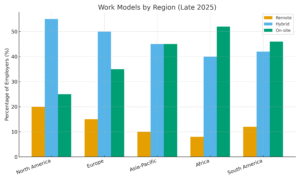Remote Work at the Dawn of 2025: Why Employers Still Hold Back (and How We Can Fix It Together)
Hey everyone — as we close out 2025, I wanted to share some thoughts from the recruiting side. Over the past few months, I’ve noticed a trend that might sound familiar to many of you: employers are still hesitant to embrace fully remote hiring.
Hybrid? Sure, it’s everywhere. On-site? Still the default in many regions. But fully remote? That’s where things get tricky. Let’s unpack what’s going on, using some fresh data from late 2025.
The Global Snapshot: Remote vs. Hybrid vs. On-site
| Continent | % Remote (fully) | % Hybrid | % Fully on-site | Notes & key sources |
| North America | ~25% | ~50% | ~25% | Based on recent U.S. polling & job-posting analyses showing hybrid remains dominant (Gallup: ~51% hybrid among remote-capable employees; Robert Half & sector job-post trends show hybrid job postings growing). (Gallup.com) |
| Europe | ~20% | ~55% | ~25% (on-site concentrated in some countries) | European employers continue to favor hybrid arrangements overall; country variation is large (Nordic/UK higher remote, some Central/Eastern states more on-site). Estimation used pan-European analyses and recruiter reports updated in last 3 months. (roberthalf.com) |
| Asia (incl. APAC) | ~10–15% | ~50–60% | ~25–35% | Recent Asia-Pacific barometer & industry reports indicate hybrid is becoming more permanent but Asia still contains many office-centric markets; some APAC firms are increasing on-site requirements (reports from JLL / PeopleMatters). (sea.peoplemattersglobal.com) |
| Oceania (Australia / NZ) | ~20–30% | ~50% | ~20–30% | Patterns similar to UK/US with strong hybrid preference in white-collar sectors (recruiter reports). (roberthalf.com) |
| South America | ~10–20% | ~50% | ~30–40% | Fewer large, up-to-date continent-level studies; market reports and employer anecdotes indicate hybrid is common in larger firms and urban centers; on-site remains large in traditional sectors. Estimate drawn from aggregated recruiter insights. (roberthalf.com) |
The short version: hybrid rules the workplace, remote lags behind, and employers are cautious.

The U.S. and New H-1B Visa Rules
2025 brought new H-1B regulations aimed at prioritizing higher-wage, higher-skilled roles. Good news for tech companies hiring top talent, but tricky for startups and SMEs that rely on international applicants.
And here’s the paradox: even when roles could be done remotely, many employers are saying, “We’d rather struggle to fill locally than open it fully remote.”
Source: USCIS Policy Update 2025.
Europe’s Struggles
Europe hasn’t had it easy this year. Between sluggish growth, rising energy costs, and persistent inflation, employers have tightened their belts.
Even in industries like IT, marketing, or finance — where remote is technically easy — companies often ignore remote international candidates, preferring EU-based hires (even if the talent pool is smaller).
Source: Eurostat Labour Market Report 2025.
Political & Economic Shocks Worldwide
Wars in Eastern Europe and the Middle East, plus ongoing financial instability in parts of Africa and South America, have made employers risk-averse. The result? Many organizations stick to “safe” hiring zones, pushing remote global recruitment further down the list.
Sources: World Bank Global Outlook 2025, ILO Employment Trends 2025.
So What Can We Do?
This isn’t just about companies being “stubborn.” It’s about uncertainty. Employers worry about:
- Legal compliance when hiring globally.
- Productivity and engagement in distributed teams.
- Political risks and unstable markets.
But here’s where we (recruiters, employers, job-seekers) can step in:
- Promote trust→ Build clear processes for remote onboarding, communication, and accountability.
- Educate employers→ Share case studies of remote success stories in their industry.
- Leverage platforms→ Use tools that simplify global compliance (like Deel, Remote, Oyster).
- Start small→ Employers can trial remote for certain roles/projects before scaling up.
Let’s Find Solutions Together
I believe that balancing remote, hybrid, and on-site work isn’t just a workplace issue — it’s an economic one. More flexibility means broader access to talent, more innovation, and ultimately, more growth.
But I don’t have all the answers.
What solutions do you see to re-balance the job market and help employers feel confident hiring remote again?
Drop your thoughts in the comments — let’s spark a conversation that could benefit all of us in 2026 and beyond.
Resources
- https://www.eurofound.europa.eu/en/surveys-and-data/surveys/european-working-conditions-survey
- https://www.ilo.org/sites/default/files/2025-01/WESO25_Trends_Report_EN.pdf
- https://ec.europa.eu/eurostat/web/products-eurostat-news/w/ddn-20250912-1
- https://ec.europa.eu/eurostat/web/products-eurostat-news/w/ddn-20250912-3
- https://www.oecd.org/content/dam/oecd/en/publications/reports/2025/07/oecd-employment-outlook-2025_5345f034/194a947b-en.pdf
- https://www.uscis.gov/sites/default/files/document/memos/H1B_Proc_Memo_FINAL.pdf
- https://www.whitehouse.gov/presidential-actions/2025/09/restriction-on-entry-of-certain-nonimmigrant-workers/
- https://www.gallup.com/401384/indicator-hybrid-work.aspx
- https://reports.weforum.org/docs/WEF_Global_Risks_Report_2025.pdf
- https://www.jobbatical.com/blog/whats-causin-talent-shortages-europe
- https://www.theguardian.com/money/2025/sep/29/uk-graduates-and-healthcare-workers-worst-hit-as-jobs-market-cools
- https://www.eurofound.europa.eu/en/publications/all/shaping-future-work-inside-europes-hybrid-work-strategies
- https://www.roberthalf.com/us/en/insights/research/remote-work-statistics-and-trends
- https://www.eurofound.europa.eu/en/topics/teleworking
- https://www.uscis.gov/newsroom/alerts/h-1b-faq
